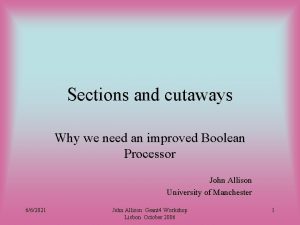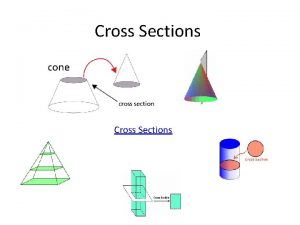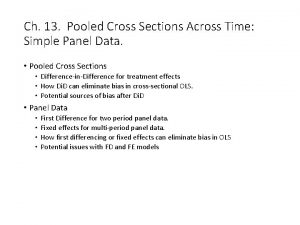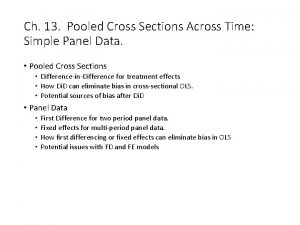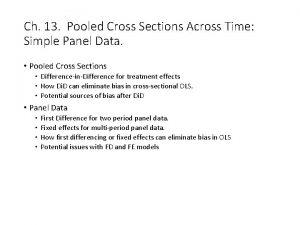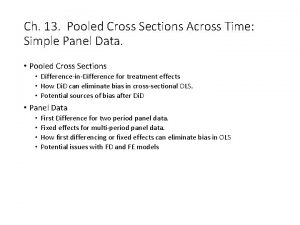Chapter 13 Pooling Cross Sections across Time Simple








- Slides: 8

Chapter 13 Pooling Cross Sections across Time: Simple Panel Data Methods © 2016 Cengage Learning®. May not be scanned, copied or duplicated, or posted to a publicly accessible website, in whole or in part, except for use as permitted in a license distributed with a certain product or service or otherwise on a password-protected website or school-approved learning management system for classroom use. © kentoh/Shutterstock.

Pooling Cross Sections across Time: Simple Panel Data Methods ● Policy analysis with pooled cross sections • Two or more independently sampled cross sections can be used to evaluate the impact of a certain event or policy change ● Example: Effect of new garbage incinerator’s location on housing prices • Examine the effect of the location of a house on its price before and after the garbage incinerator was built: After incinerator was built Before incinerator was built © 2016 Cengage Learning®. May not be scanned, copied or duplicated, or posted to a publicly accessible website, in whole or in part, except for use as permitted in a license distributed with a certain product or service or otherwise on a password-protected website or school-approved learning management system for classroom use.

Pooling Cross Sections across Time: Simple Panel Data Methods ● Example: Garbage incinerator and housing prices (cont. ) • It would be wrong to conclude from the regression after the incinerator is there that being near the incinerator depresses prices so strongly • One has to compare with the situation before the incinerator was built: • In the given case, this is equivalent to Incinerator depresses prices but location was one with lower prices anyway ● This is the so called difference-in-differences estimator (Di. D) © 2016 Cengage Learning®. May not be scanned, copied or duplicated, or posted to a publicly accessible website, in whole or in part, except for use as permitted in a license distributed with a certain product or service or otherwise on a password-protected website or school-approved learning management system for classroom use.

Pooling Cross Sections across Time: Simple Panel Data Methods ● Difference-in-differences in a regression framework Differential effect of being in the location and after the incinerator was built • In this way standard errors for the Di. D-effect can be obtained • If houses sold before and after the incinerator was built were systematically different, further explanatory variables should be included • This will also reduce the error variance and thus standard errors ● Before/After comparisons in “natural experiments” • Di. D can be used to evaluate policy changes or other exogenous events © 2016 Cengage Learning®. May not be scanned, copied or duplicated, or posted to a publicly accessible website, in whole or in part, except for use as permitted in a license distributed with a certain product or service or otherwise on a password-protected website or school-approved learning management system for classroom use.

Pooling Cross Sections across Time: Simple Panel Data Methods ● Policy evaluation using difference-in-differences Compare outcomes of the two groups before and after the policy change Compare the difference in outcomes of the units that are affected by the policy change (= treatment group) and those who are not affected (= control group) before and after the policy was enacted. For example, the level of unemployment benefits is cut but only for group A (= treatment group). Group A normally has longer unemployment durations than group B (= control group). If the difference in unemployment durations between group A and group B becomes smaller after the reform, reducing unemployment benefits reduces unemployment duration for those affected. Caution: Difference-in-differences only works if the difference in outcomes between the two groups is not changed by other factors than the policy change (e. g. there must be no differential trends). © 2016 Cengage Learning®. May not be scanned, copied or duplicated, or posted to a publicly accessible website, in whole or in part, except for use as permitted in a license distributed with a certain product or service or otherwise on a password-protected website or school-approved learning management system for classroom use.

Pooling Cross Sections across Time: Simple Panel Data Methods ● Two-period panel data analysis ● Example: Effect of unemployment on city crime rate • Assume that no other explanatory variables are available. Will it be possible to estimate the causal effect of unemployment on crime? • Yes, if cities are observed for at least two periods and other factors affecting crime stay approximately constant over those periods: Time dummy for the second period Unobserved time-constant factors (= fixed effect) Other unobserved factors (= idiosyncratic error) © 2016 Cengage Learning®. May not be scanned, copied or duplicated, or posted to a publicly accessible website, in whole or in part, except for use as permitted in a license distributed with a certain product or service or otherwise on a password-protected website or school-approved learning management system for classroom use.

Pooling Cross Sections across Time: Simple Panel Data Methods ● Example: Effect of unemployment on city crime rate (cont. ) Subtract: Fixed effect drops out ● Estimate differenced equation by OLS: + 1 percentage point unemployment rate leads to 2. 22 more crimes per 1, 000 people Secular increase in crime © 2016 Cengage Learning®. May not be scanned, copied or duplicated, or posted to a publicly accessible website, in whole or in part, except for use as permitted in a license distributed with a certain product or service or otherwise on a password-protected website or school-approved learning management system for classroom use.

Pooling Cross Sections across Time: Simple Panel Data Methods ● Discussion of first-differenced panel estimator • Further explanatory variables may be included in original equation • Note that there may be arbitrary correlation between the unobserved time-invariant characteristics and the included explanatory variables • OLS in the original equation would therefore be inconsistent • The first-differenced panel estimator is thus a way to consistently estimate causal effects in the presence of time-invariant endogeneity • For consistency, strict exogeneity has to hold in the original equation • First-differenced estimates will be imprecise if explanatory variables vary only little over time (no estimate possible if time-invariant) © 2016 Cengage Learning®. May not be scanned, copied or duplicated, or posted to a publicly accessible website, in whole or in part, except for use as permitted in a license distributed with a certain product or service or otherwise on a password-protected website or school-approved learning management system for classroom use.

